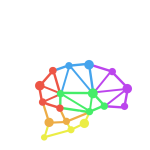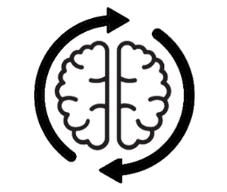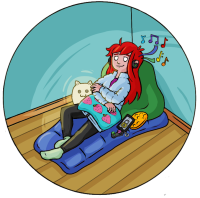Pro Tips Home
Download the .pdf guide
What is cognitive load?
People process incoming information and thought using limited brain power, and the amount of power used is called cognitive load.
The more information and more things to process at once, the less power the brain has to complete difficult tasks: like learning, emotion regulation, and attention. When cognitive load reaches a point where functioning becomes difficult, we call it overload or overstimulation.
Autistic and neurodivergent brains can be more prone to overload, because incoming information activates different pathways and different regions of the brain, and the brain processes and responds differently.
Some videos that may help explain:
- Video: Neuroscience of Cognitive Load
- Videos: Sensory Perception & Cognitive Overload
- Video: Sensory Sensitivities in Autism: From Narratives to Neuroscience with Dr. Greg Siegle
What causes overload, and what does it look like?
Things that add to cognitive load rarely happen in isolation, and when these inputs overlap, overload can happen far more quickly. Difficult situations often involve extreme amounts of these inputs, often all at once.
| Social Information | Understanding speech, social rules, and non-verbal communication. |
| Social Interactions | Communicating with others, speaking and responding. Masking traits. |
| Sensory information | Information from multiple senses, including things like bright light and loud sounds. |
| Our Emotions | Intense emotions, recognizing what we are feeling, and regulating how we respond. |
| Conscious tasks | Thinking, planning & deciding, remembering, attention, and taking action. |
We can react to overload in different ways...
| Meltdowns | Intense outbursts of emotion. |
| Shutdowns | Becoming distant or losing the ability to respond. |
What can help?
It’s important to do what you can to lighten the work your brain has to do on the spot, leaving you more cognitive space for the task at hand.
There are two major things to focus on:
 Lowering Incoming Information
Lowering Incoming Information
 Coping with Overload
Coping with Overload
- Recognizing Self Judgements
-
Others, especially neurotypicals, do not experience the world in the same way.
To them, different perspectives and overload reactions may seem unreasonable or shocking, even if they are physical ways our brains react to what’s happening that are out of our control.
People often invalidate different experiences they don’t understand, like calling them wrong or overly dramatic.
When things that seem so easy to others feel so overwhelming to us, we can begin to feel like there is something wrong with.
The way others respond and the feelings we develop can lead to long term self judgement and embarrassment.
It is important to validate our different experiences, and to take steps to help reduce overload instead of just tolerating it.
- Asking for help
-
It is okay to ask for help and for accommodations that you need.
We may not always get the help we need. People can react to with ignorance or be dismissive. That does not mean asking for help is wrong, or that you are wrong for needing help.
If you do not have support with family and friends, there may be resources like advocacy organizations, coaches, and other professionals that can help.
Sometimes, we have no access to these outsides supports. This may feel lonely and helpless, but there may be ways to help yourself even when you cannot change the people and environments in your life.
Lowering Incoming Information
 Reducing overload risk can be as simple as reducing the amount of information coming into our brains. With less things to process, more brain power can be used to do things we need to do and tolerate the things we cannot control.
Reducing overload risk can be as simple as reducing the amount of information coming into our brains. With less things to process, more brain power can be used to do things we need to do and tolerate the things we cannot control.
- Things that contribute to overload
-
We may not even be aware of how much certain things affect us until we find ways to reduce them. It’s always worth trying these strategies if you are struggling.
Sensory Be mindful of all of your unique sensory sensitivities and be prepared ahead of time with tools to navigate difficult sensory environments. Body Sensations
The way our body feels can also contribute feeling overloaded as much as outside sensory input.
Some of us struggle to recognize these feelings when they happen.
- Feeling overheated or cold
- Feeling hungry or thirsty
- Feeling physical pain or exhaustion
- Tired or missing sleep
Social Social interactions are needed and sometimes healthy for us to explore but be aware of how different social interactions add to overload for you.
Examples of ways to reduce social pressure:
- Not forcing eye contact or other body language changes that are difficult for you
- Not engaging in extra social interactions outside of your goals, like chatting with strangers at the store.
Emotions Don’t forgot that emotions add to cognitive overload, and it’s harder to manage emotions when overloaded!
It’s okay to do something another time if you cannot handle it now.
Routines Large disruptions to your routine can make things more overwhelming.
- Sudden changes to your schedule or expectation for the day
- Big life changes going on
- Trying a new thing, or going somewhere new
Making an activity part of your routine can also make it less stressful.
- Tools
-
Ear Plugs
- Simple silicon or foam ear plugs are also very affordable
- Non-disposable ear plugs offer different levels of sound reduction (example: Loop ear plugs)
Headphones - Ear buds or over-the-ear headphones can dampen sound as well as play music that can help you regulate
- Some headsets come with active noise cancellation tech
Sunglasses - Outdoor sunglasses can help with brightness and glare
- Indoor glasses are lightly tinted to reduce intensity of light
Clothing Choice
- Avoiding uncomfortable fabrics, and removing tags
- Avoiding uncomfortable fits (too tight or too loose)
Gloves - Wearing gloves during difficult tactile experiences
- Long sleeves can also help
Masks - Masks can help reduce scent and reduce exposure to chemicals or allergens you might be sensitive to
- Masks can also ease social pressure because you don’t need to focus so hard on your facial expressions.
Temperature Regulation - Hats, umbrellas, or long sleeves can shield from the sun
- Clothing that is lighter or that wicks sweat (such as exercise-related clothing)
- Ice packs or towels cooled in the freezer
Coping with Overload
 We cannot always prevent incoming information and overload, and self-regulating can help our brains cope.
We cannot always prevent incoming information and overload, and self-regulating can help our brains cope.
We can self-regulate tools and techniques that help calm our minds and bodies. These can help calm the physical systems in our bodies that make us feel stressed.
- Stimming
-
We can also use repetitive sensory seeking actions, something often called “stimming”. This “positive” sensory input can help the brain cope with overload, even if it seems counterintuitive.
You might feel embarrassed about using some self-regulation techniques, but they can be a big help and are nothing to be ashamed of.
If stimming is very intense, disruptive, or harmful to you, try to redirect to a safer type of stim.
Body Movement Moving the body actively, like taking a walk or doing yoga. Taking a moment Taking a break, especially in a quiet or private spot. Weight or Vibration Calming weight or vibration that calms the body’s stress response. Stimming Movements Certain calming motions, like rocking, flapping, and many more. Stimming Tools Using items like fidgets, tools, and toys. - Safe Spaces
-
A safe space can be helpful when coping with overload:
This is a place with less overwhelming sensory input (such as quiet or low light), but it can also include positive coping aspects (like stim items, music)
When in public: a family bathroom, bathroom stall, or at locations like your own car. Some locations have rooms specific to this purpose, like sensory rooms, that you can ask about.
 When at home: it helps to have a designated safe space for yourself to go when overwhelmed, even if it’s just for a short time, and regulate.
When at home: it helps to have a designated safe space for yourself to go when overwhelmed, even if it’s just for a short time, and regulate.This could be an entire room (like a bedroom), a small space like a closet, or even something like an indoor tent. For some, this may even be a garden or a walk in the woods.
- Tools
-
Stim &
Fidget Items
Explore: there is a wide variety of stim/sensory or fidget items available, and what helps you is unique to you.
Here are just a few ideas
Tactile:- Some items are small and quiet (helpful in public!) to try:
- Flippy chains, fidget rings, hand rollers, stress balls
- Other examples to try:
- Hand activity fidgets (rings, cubes, and other toys)
- Chewing Fidgets, like silicon "chewlery"
- Pure texture items, like textured tape, plushies
- Wall projectors, like nebula or star projectors
- Light up or glow items, like glow cubes or balls
- Silicon poppers (also tactile)
- Snap and click toys
Weighted Items Try: Weighted blankets, weighted lap pads, or weighted plushies
Weighted items can feel overwhelming at first, give it some time.
Vibrating Items Try: Vibrating pillows, back massagers, or vibration wrist bands
These items can provide calming feed back to our bodies key stress systems but are less commonly mentioned.
Music &
White Noise
For many, music can be an extremely effective at reducing overwhelm.
White noise can also buffer auditory input and reduce overwhelm.
- Some items are small and quiet (helpful in public!) to try:
